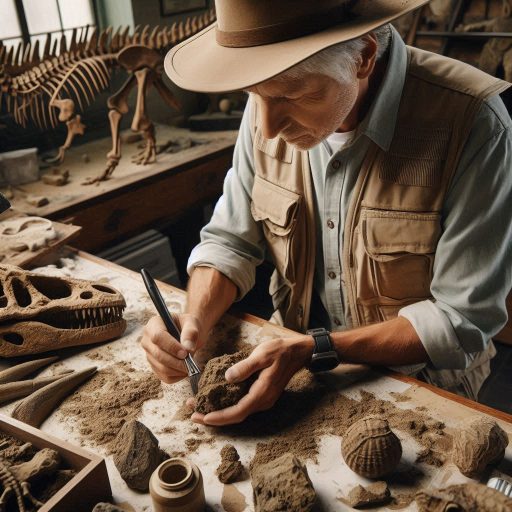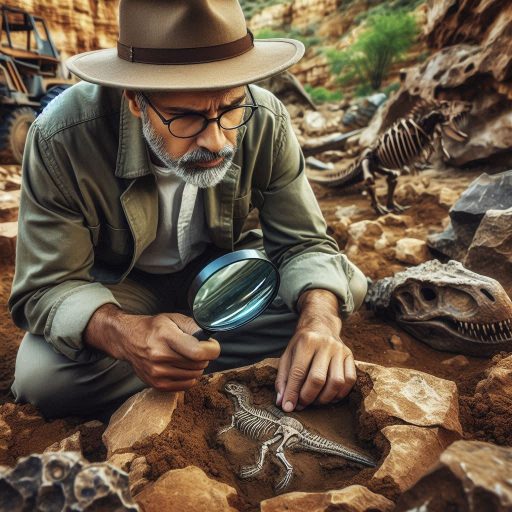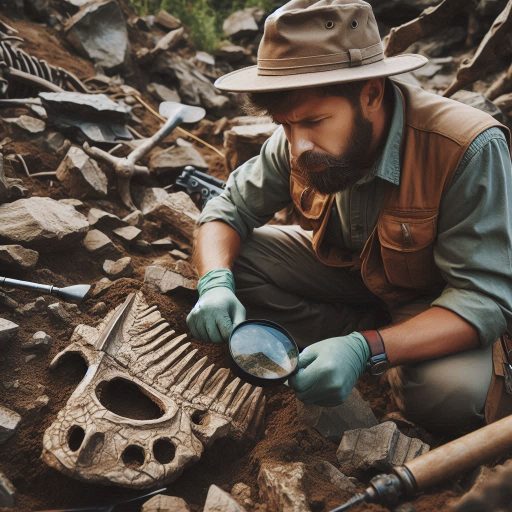Introduction
Paleontology is the study of ancient life through fossils and geological records.
This scientific discipline plays a significant role in understanding Earth’s history and evolution.
Paleontologists uncover clues about prehistoric organisms, their habitats, and their interactions within ecosystems.
By analyzing fossil evidence, scientists can reconstruct past environments and better understand the complex processes that shaped life on Earth.
Movies and books often portray paleontology in exciting and engaging ways.
Iconic films like Jurassic Park and novels such as The Lost World bring dinosaurs and prehistoric creatures to life, captivating audiences worldwide.
These narratives blend adventure and science, sparking curiosity about ancient life forms and their environments.
They allow audiences to imagine the world millions of years ago, evoking wonder and fascination.
Popular culture significantly influences how society perceives paleontology.
Through thrilling stories and vivid imagery, it simplifies complex scientific concepts for the general public.
This accessibility fosters interest in paleontology, encouraging more people to explore this fascinating field.
Furthermore, popular media can inspire young people to pursue careers in science, technology, engineering, and mathematics (STEM).
The portrayal of paleontology in movies and books also leads to discussions about scientific accuracy.
While some stories take creative liberties, they can motivate viewers and readers to learn more about actual paleontological research.
History of Paleontology in Popular Culture
Evolution of Paleontological Themes
From the early days of cinema and literature, paleontological themes have evolved significantly.
In the early 20th century, movies and books often portrayed paleontologists as adventurous heroes uncovering ancient mysteries.
These portrayals were heavily influenced by the exciting discoveries of real-life paleontologists like Roy Chapman Andrews and Mary Anning.
As the field of paleontology evolved, so did its portrayal in popular culture.
In the mid-20th century, movies like “Jurassic Park” introduced audiences to the idea of cloning dinosaurs and bringing them back to life.
This sparked a renewed interest in paleontology and sparked a wave of dinosaur-themed movies and books.
Impact of Early Portrayals on Public Perception
The early portrayals of paleontology as a thrilling and adventurous field had a significant impact on the public perception of paleontologists.
Before these portrayals, paleontologists were often seen as dry academics working in dusty museums.
However, after seeing them portrayed as daring explorers unearthing ancient creatures, the public began to view paleontology in a new light.
These early portrayals also helped to popularize paleontology and inspire a new generation of scientists.
Many paleontologists cite movies and books as their initial inspiration for pursuing a career in the field.
This increased interest in paleontology has led to more funding for research and greater public awareness of the importance of studying Earth’s history.
Examples of Popular Works Featuring Paleontology
There are countless examples of popular works that have featured paleontology in one form or another.
From classic novels like “Journey to the Center of the Earth” to blockbuster movies like “Jurassic Park,” paleontology has been a recurring theme in popular culture.
- Jurassic Park: Steven Spielberg’s 1993 film adaptation of Michael Crichton’s novel revolutionized how dinosaurs were portrayed on screen.
- Walking with Dinosaurs: This BBC documentary series used cutting-edge CGI to recreate dinosaurs in their natural habitats.
- Land Before Time: A beloved animated film that follows a group of young dinosaurs on a journey to find a new home.
- Jurassic World: The modern sequel to the original “Jurassic Park” franchise continues to captivate audiences with new dinosaur adventures.
These examples are just a small sampling of the many works that have featured paleontology.
Whether they’re educational documentaries or action-packed blockbusters, paleontology continues to be a popular theme in movies and books.
In general, paleontology has had a long and storied history in popular culture.
From early portrayals that shaped public perception to modern blockbusters that inspire a new generation of scientists.
Paleontology continues to capture the imagination of audiences worldwide.
Accuracy vs. Creative License
When it comes to paleontology in popular culture, there is often a delicate balance that creators must strike between scientific accuracy and entertainment value.
While it is important for representations of paleontology to be as true to the science as possible, creators also need to engage their audience and keep them entertained.
Discussion on the balance between scientific accuracy and entertainment value
- Creators often face the challenge of accurately depicting paleontological concepts while also making them engaging for a general audience.
- Some choose to prioritize entertainment value over scientific accuracy, resulting in unrealistic portrayals of paleontology in movies and books.
- However, striking a good balance between accuracy and entertainment can lead to successful portrayals of paleontology that both educate and entertain.
- One way to achieve this balance is by consulting with experts in the field to ensure that the science is accurately represented while still being engaging.
Critique of popular culture’s portrayal of paleontology
- Despite the efforts of some creators to accurately depict paleontology, popular culture often falls short in its portrayal of the field.
- Many movies and books take creative liberties with paleontological concepts, leading to misconceptions and inaccuracies being perpetuated.
- These inaccurate portrayals can have a negative impact on public perception of paleontology, leading to misunderstandings about the field.
- It is crucial for creators to take responsibility for accurately representing paleontology in popular culture to avoid spreading misinformation.
Responsibility of creators to accurately represent the field
- Creators have a responsibility to accurately represent paleontology in popular culture to ensure that the science is portrayed in a positive light.
- By consulting with experts and doing proper research, creators can provide audiences with an engaging and accurate portrayal of paleontology.
- Accurate representations of paleontology can help educate the public about the field and inspire interest in scientific discovery.
- Ultimately, creators have the power to shape how paleontology is perceived in popular culture and should strive for accuracy in their portrayals.
Read: Essential Skills and Tools for Modern Chemists in America
Paleontology in Movies
Analysis of Popular Films Featuring Paleontology
Movies featuring paleontology have captured audiences’ imaginations for decades.
Films like “Jurassic Park” and “The Land Before Time” have become iconic representations of dinosaurs.
These films often blend science with entertainment, bringing paleontological concepts to the mainstream.
While many portray a thrilling adventure, they also introduce viewers to paleontological themes.
“Jurassic Park,” directed by Steven Spielberg, revolutionized the portrayal of dinosaurs in cinema.
The film utilized groundbreaking CGI to depict lifelike dinosaurs, capturing public interest.
It sparked curiosity about paleontology, inspiring many to explore this scientific field.
The film also raised ethical questions about genetic engineering and the revival of extinct species.
In contrast, animated films like “The Land Before Time” present a more child-friendly depiction of dinosaurs.
This film highlights friendship and adventure while introducing young viewers to prehistoric creatures.
Such films play an essential role in shaping early perceptions of paleontology.
Influence of Movies on Public Interest in the Field
Movies have a significant influence on public interest in paleontology.
They spark curiosity and encourage audiences to learn more about ancient life.
For many, these films serve as a gateway to the scientific world of paleontology.
The excitement generated by paleontological films often leads to increased enrollment in related educational programs.
Many viewers feel inspired to pursue careers in paleontology after watching these movies.
They ignite a passion for understanding Earth’s history and its prehistoric inhabitants.
Moreover, these films can boost museum attendance and participation in educational programs.
When movies featuring dinosaurs are released, museums often see an influx of visitors.
They capitalize on this interest by offering exhibits related to the film‘s themes.
This trend demonstrates how popular culture can enhance public engagement with science.
Comparison Between Different Genres and Their Approach to Paleontology
Different film genres approach paleontology in unique ways.
Action-adventure films, like “Jurassic Park,” emphasize thrilling encounters with dinosaurs.
These films focus on excitement, danger, and ethical dilemmas surrounding scientific advancements.
They often prioritize spectacle over accuracy, captivating audiences through drama.
On the other hand, documentaries offer a more factual representation of paleontology.
Films such as “Walking with Dinosaurs” provide detailed insights into prehistoric life.
These documentaries focus on education, showcasing the latest scientific discoveries and theories.
They strive for accuracy, often collaborating with paleontologists to depict realistic scenarios.
Animated films take a different approach by appealing to younger audiences.
They simplify complex concepts while entertaining and educating.
By creating relatable characters, these films encourage children to develop an interest in science.
In review, movies have a profound impact on the public perception of paleontology.
Through various genres, they entertain and educate audiences about ancient life.
While some films prioritize drama and excitement, others aim for accuracy and education.
Regardless of the approach, these films play a vital role in promoting interest in paleontology and its importance in understanding our planet’s history.
Read: The Role of Chemists in US Environmental and Sustainability Efforts
Paleontology in Books
Books have played a crucial role in depicting paleontology in literature.
They serve as a tool for educating and inspiring readers about the wonders of paleontology.
Here are some key points to consider when exploring this topic
Exploration of how paleontology is depicted in literature
- Authors often use paleontological themes to create fascinating storylines that revolve around ancient creatures and lost worlds.
- The depiction of paleontology in books can vary, from accurate scientific descriptions to creative liberties taken to enhance the narrative.
- Many books delve into the process of fossil discovery, excavation, and the reconstruction of prehistoric creatures, offering readers a glimpse into the world of paleontology.
Role of books in educating and inspiring readers about paleontology
- Books serve as a valuable source of information for readers interested in learning about the history of life on Earth and the work of paleontologists.
- By incorporating paleontological themes into their stories, authors can ignite readers’ curiosity and inspire them to explore the field of paleontology further.
- Through vivid descriptions and engaging narratives, books can transport readers to ancient eras and introduce them to the fascinating creatures that once roamed the Earth.
Examples of well-known books that highlight paleontological themes
- “Jurassic Park” by Michael Crichton: This iconic novel explores the concept of bringing dinosaurs back to life through genetic engineering, showcasing the dangers and wonders of paleontology.
- “The Lost World” by Sir Arthur Conan Doyle: This classic novel follows a group of explorers on a journey to a hidden plateau in South America where dinosaurs still roam, blending adventure with paleontological discoveries.
- “My Beloved Brontosaurus” by Brian Switek: This non-fiction book offers a captivating look at the world of dinosaurs and the science of paleontology, providing readers with insights into the latest research and discoveries in the field.
Overall, books have played a crucial role in shaping our understanding and fascination with paleontology.
They offer a gateway to ancient worlds, allowing readers to explore the mysteries of prehistoric life and the work of paleontologists in uncovering the secrets of the past.
Read: Day in the Life: An Environmental Scientist‘s Typical Day

Impact on Paleontological Community
Examination of the Influence of Popular Culture on the Paleontological Community
Popular culture significantly influences the perception of paleontology.
Movies, books, and television shows bring dinosaurs and ancient life to the forefront of public interest.
This influence often leads to increased enthusiasm for paleontology among young audiences.
As a result, many students pursue careers in the field due to early exposure to these captivating stories.
However, popular culture also presents challenges.
Often, media portrayals emphasize dramatic elements over scientific accuracy.
This can lead to misconceptions about paleontological practices and findings.
Misrepresentation of dinosaurs and their behaviors can skew public understanding.
For instance, films often depict dinosaurs as terrifying monsters, overshadowing their complex behaviors and ecosystems.
Collaboration Between Scientists and Creators in Media
Collaboration between scientists and media creators can bridge the gap between entertainment and education.
Many documentaries and films involve paleontologists to ensure accuracy in their representations.
Scientists provide insights into the latest research, enhancing the narrative’s educational value.
This partnership benefits both parties; filmmakers gain authenticity while scientists reach wider audiences.
For example, the popular documentary series “Walking with Dinosaurs” consulted paleontologists extensively.
This collaboration resulted in a more accurate portrayal of prehistoric life.
The series inspired viewers to explore the scientific aspects of paleontology.
Such projects show the potential for media to educate while entertaining.
Scientists also engage with social media platforms to share knowledge.
Through blogs, videos, and podcasts, they communicate current research to a broader audience.
This direct interaction helps demystify the field and encourages curiosity about paleontology.
How Popular Culture Can Help or Hinder Paleontological Research and Knowledge
Popular culture can significantly aid paleontological research and public knowledge.
It raises awareness about fossil discoveries and ongoing research efforts.
Books like “Jurassic Park” spark interest in dinosaurs and lead to more public support for paleontological initiatives.
Increased funding and interest can arise from heightened awareness and excitement.
However, sensationalized portrayals can also hinder understanding.
When films prioritize spectacle over science, they may mislead the audience.
This can result in a public misunderstanding of paleontological practices.
For example, some movies depict fossil excavation as easy and glamorous, undermining the hard work involved.
Additionally, exaggerated depictions can overshadow real paleontological challenges.
Issues like climate change and habitat loss deserve public attention, but they often go unnoticed.
This lack of focus can hinder research efforts and support for conservation initiatives.
Generally, popular culture significantly influences the paleontological community.
While it can inspire future scientists, it also presents challenges related to accuracy and understanding.
Collaborations between scientists and media creators can bridge these gaps, leading to more responsible portrayals.
By emphasizing educational value, popular culture can enhance public knowledge of paleontology while supporting ongoing research and conservation efforts.
Transform Your Career Today
Unlock a personalized career strategy that drives real results. Get tailored advice and a roadmap designed just for you.
Start NowRead: The Impact of Technology on the Chemist Profession in the US
Cultural Significance of Paleontology
When we delve into the realm of paleontology, we not only uncover ancient remains but also unravel the layers of societal values and beliefs that are embedded in our cultural narratives.
The significance of paleontology goes beyond just scientific discoveries; it reflects our deep-rooted fascination with the mysteries of the past.
Examination of Societal Values and Beliefs
- Paleontology serves as a mirror to society, showcasing how we view the natural world and our place within it.
- Through paleontological discoveries, we can see how cultures have interpreted and interacted with extinct creatures.
- The study of ancient life forms provides insights into how humans have evolved and adapted over time.
- By studying fossils, we gain a greater understanding of our own existence and the interconnectedness of all living beings.
Connection between Discoveries and Cultural Narratives
- Paleontological findings often influence cultural narratives, shaping our stories, myths, and legends.
- Dinosaurs, in particular, have become iconic symbols in popular culture, representing power, mystery, and extinction.
- These ancient creatures have inspired countless books, movies, and works of art, fueling our imagination and creativity.
- Through the lens of paleontology, we can explore how societies have interpreted and adapted to changes in the natural world.
Exploration of Fascination with Dinosaurs
- Our fascination with dinosaurs stems from a deep-seated curiosity about the Earth’s history and the creatures that once roamed it.
- Dinosaurs captivate our imagination because they represent a time when the world was vastly different from what we know today.
- From the towering Tyrannosaurus Rex to the gentle Brachiosaurus, each dinosaur species sparks awe and wonder in both children and adults.
- Through paleontology, we can bridge the gap between the past and the present, connecting with ancient beings in a meaningful way.
Explore Further: How to Prepare for a Career in Virology During College
Learn More: Popular Forensic Science Specializations
Conclusion
In this blog, we explored the significant influence of paleontology in popular culture, particularly in movies and books.
Iconic films like Jurassic Park and bestselling novels such as The Lost World have shaped public perception of dinosaurs and ancient life forms.
These representations can ignite curiosity and inspire future generations of paleontologists, making the science accessible and engaging.
However, it is crucial to emphasize the importance of accurate and thoughtful representation in these media.
While entertainment is a primary goal, misleading portrayals can create misconceptions about paleontological science and its discoveries.
For instance, depicting dinosaurs with exaggerated features or behaviors can distort public understanding of their biology and ecosystems.
Creators should strive to balance entertainment with educational value, ensuring that audiences receive factual information alongside thrilling narratives.
I encourage filmmakers, authors, and other content creators to continue inspiring curiosity and interest in paleontology through popular media.
By weaving accurate science into engaging stories, they can foster a love for paleontology in their audiences.
Collaborating with scientists and experts can enhance the authenticity of their portrayals while still captivating viewers and readers.
Furthermore, promoting accurate depictions of paleontology can lead to increased interest in the field.
[E-Books for Sale]
The Big Book of 500 High-Paying Jobs in America: Unlock Your Earning Potential
$19.99 • 500 High-Paying Jobs • 330 pages
Explore 500 high-paying jobs in America and learn how to boost your career, earn more, and achieve success!
See All 500 High-Paying Jobs of this E-Book
1001 Professions Without a Degree: High-Paying American Jobs You Can Start Now
$19.99 • 1001 Professions Without a Degree • 174 pages
Discover 1001 high-paying jobs without a degree! Unlock career tips, skills, and success strategies for just $19.99!




